9.3: Poverty
- Page ID
- 3533
\( \newcommand{\vecs}[1]{\overset { \scriptstyle \rightharpoonup} {\mathbf{#1}} } \)
\( \newcommand{\vecd}[1]{\overset{-\!-\!\rightharpoonup}{\vphantom{a}\smash {#1}}} \)
\( \newcommand{\dsum}{\displaystyle\sum\limits} \)
\( \newcommand{\dint}{\displaystyle\int\limits} \)
\( \newcommand{\dlim}{\displaystyle\lim\limits} \)
\( \newcommand{\id}{\mathrm{id}}\) \( \newcommand{\Span}{\mathrm{span}}\)
( \newcommand{\kernel}{\mathrm{null}\,}\) \( \newcommand{\range}{\mathrm{range}\,}\)
\( \newcommand{\RealPart}{\mathrm{Re}}\) \( \newcommand{\ImaginaryPart}{\mathrm{Im}}\)
\( \newcommand{\Argument}{\mathrm{Arg}}\) \( \newcommand{\norm}[1]{\| #1 \|}\)
\( \newcommand{\inner}[2]{\langle #1, #2 \rangle}\)
\( \newcommand{\Span}{\mathrm{span}}\)
\( \newcommand{\id}{\mathrm{id}}\)
\( \newcommand{\Span}{\mathrm{span}}\)
\( \newcommand{\kernel}{\mathrm{null}\,}\)
\( \newcommand{\range}{\mathrm{range}\,}\)
\( \newcommand{\RealPart}{\mathrm{Re}}\)
\( \newcommand{\ImaginaryPart}{\mathrm{Im}}\)
\( \newcommand{\Argument}{\mathrm{Arg}}\)
\( \newcommand{\norm}[1]{\| #1 \|}\)
\( \newcommand{\inner}[2]{\langle #1, #2 \rangle}\)
\( \newcommand{\Span}{\mathrm{span}}\) \( \newcommand{\AA}{\unicode[.8,0]{x212B}}\)
\( \newcommand{\vectorA}[1]{\vec{#1}} % arrow\)
\( \newcommand{\vectorAt}[1]{\vec{\text{#1}}} % arrow\)
\( \newcommand{\vectorB}[1]{\overset { \scriptstyle \rightharpoonup} {\mathbf{#1}} } \)
\( \newcommand{\vectorC}[1]{\textbf{#1}} \)
\( \newcommand{\vectorD}[1]{\overrightarrow{#1}} \)
\( \newcommand{\vectorDt}[1]{\overrightarrow{\text{#1}}} \)
\( \newcommand{\vectE}[1]{\overset{-\!-\!\rightharpoonup}{\vphantom{a}\smash{\mathbf {#1}}}} \)
\( \newcommand{\vecs}[1]{\overset { \scriptstyle \rightharpoonup} {\mathbf{#1}} } \)
\( \newcommand{\vecd}[1]{\overset{-\!-\!\rightharpoonup}{\vphantom{a}\smash {#1}}} \)
\(\newcommand{\avec}{\mathbf a}\) \(\newcommand{\bvec}{\mathbf b}\) \(\newcommand{\cvec}{\mathbf c}\) \(\newcommand{\dvec}{\mathbf d}\) \(\newcommand{\dtil}{\widetilde{\mathbf d}}\) \(\newcommand{\evec}{\mathbf e}\) \(\newcommand{\fvec}{\mathbf f}\) \(\newcommand{\nvec}{\mathbf n}\) \(\newcommand{\pvec}{\mathbf p}\) \(\newcommand{\qvec}{\mathbf q}\) \(\newcommand{\svec}{\mathbf s}\) \(\newcommand{\tvec}{\mathbf t}\) \(\newcommand{\uvec}{\mathbf u}\) \(\newcommand{\vvec}{\mathbf v}\) \(\newcommand{\wvec}{\mathbf w}\) \(\newcommand{\xvec}{\mathbf x}\) \(\newcommand{\yvec}{\mathbf y}\) \(\newcommand{\zvec}{\mathbf z}\) \(\newcommand{\rvec}{\mathbf r}\) \(\newcommand{\mvec}{\mathbf m}\) \(\newcommand{\zerovec}{\mathbf 0}\) \(\newcommand{\onevec}{\mathbf 1}\) \(\newcommand{\real}{\mathbb R}\) \(\newcommand{\twovec}[2]{\left[\begin{array}{r}#1 \\ #2 \end{array}\right]}\) \(\newcommand{\ctwovec}[2]{\left[\begin{array}{c}#1 \\ #2 \end{array}\right]}\) \(\newcommand{\threevec}[3]{\left[\begin{array}{r}#1 \\ #2 \\ #3 \end{array}\right]}\) \(\newcommand{\cthreevec}[3]{\left[\begin{array}{c}#1 \\ #2 \\ #3 \end{array}\right]}\) \(\newcommand{\fourvec}[4]{\left[\begin{array}{r}#1 \\ #2 \\ #3 \\ #4 \end{array}\right]}\) \(\newcommand{\cfourvec}[4]{\left[\begin{array}{c}#1 \\ #2 \\ #3 \\ #4 \end{array}\right]}\) \(\newcommand{\fivevec}[5]{\left[\begin{array}{r}#1 \\ #2 \\ #3 \\ #4 \\ #5 \\ \end{array}\right]}\) \(\newcommand{\cfivevec}[5]{\left[\begin{array}{c}#1 \\ #2 \\ #3 \\ #4 \\ #5 \\ \end{array}\right]}\) \(\newcommand{\mattwo}[4]{\left[\begin{array}{rr}#1 \amp #2 \\ #3 \amp #4 \\ \end{array}\right]}\) \(\newcommand{\laspan}[1]{\text{Span}\{#1\}}\) \(\newcommand{\bcal}{\cal B}\) \(\newcommand{\ccal}{\cal C}\) \(\newcommand{\scal}{\cal S}\) \(\newcommand{\wcal}{\cal W}\) \(\newcommand{\ecal}{\cal E}\) \(\newcommand{\coords}[2]{\left\{#1\right\}_{#2}}\) \(\newcommand{\gray}[1]{\color{gray}{#1}}\) \(\newcommand{\lgray}[1]{\color{lightgray}{#1}}\) \(\newcommand{\rank}{\operatorname{rank}}\) \(\newcommand{\row}{\text{Row}}\) \(\newcommand{\col}{\text{Col}}\) \(\renewcommand{\row}{\text{Row}}\) \(\newcommand{\nul}{\text{Nul}}\) \(\newcommand{\var}{\text{Var}}\) \(\newcommand{\corr}{\text{corr}}\) \(\newcommand{\len}[1]{\left|#1\right|}\) \(\newcommand{\bbar}{\overline{\bvec}}\) \(\newcommand{\bhat}{\widehat{\bvec}}\) \(\newcommand{\bperp}{\bvec^\perp}\) \(\newcommand{\xhat}{\widehat{\xvec}}\) \(\newcommand{\vhat}{\widehat{\vvec}}\) \(\newcommand{\uhat}{\widehat{\uvec}}\) \(\newcommand{\what}{\widehat{\wvec}}\) \(\newcommand{\Sighat}{\widehat{\Sigma}}\) \(\newcommand{\lt}{<}\) \(\newcommand{\gt}{>}\) \(\newcommand{\amp}{&}\) \(\definecolor{fillinmathshade}{gray}{0.9}\)Objectives
- Analyze the factors that contribute to poverty.
- Describe the groups that are affected by poverty.
- Describe the role government has taken to alleviate the effects of poverty in America.
- Analyze the effects of poverty on a society?
Universal Generalizations
- America is one of the richest countries in the world.
- Characteristics like age, sex, race, and ethnicity affect poverty.
- The lives of wealthy Americans greatly differ from poor Americans.
- Poor people in America have two great disadvantages health and length of life.
Guiding Questions
- What factors are used to determine poverty in the United States?
- What will most likely determine if someone will live in poverty?
- How does the government try to reduce inequality in America?
- How effective is government intervention in dealing with poverty?
Economic Inequality
Economic inequality refers to the extent of the economic difference between the rich and the poor. Because most societies are stratified, there will always be some people who are richer or poorer than others, but the key question is how much richer or poorer they are. When the gap between them is large, we say that much economic inequality exists; when the gap between them is small, we say that relatively little economic inequality exists.
The United States is one of the richest countries in the world. Still, it has a very large degree of economic inequality. A common way to examine inequality is to rank the nation’s families by income from lowest to highest and then to divide this distribution into fifths. Thus, we have the poorest fifth of the nation’s families (or the 20% of families with the lowest family incomes), a second fifth with somewhat higher incomes, and so on until we reach the richest fifth of families, or the 20% with the highest incomes. We then can see what percentage each fifth has of the nation’s entire income. "Share of National Income Going to Income Fifths, 2009" shows such a calculation for the United States. The poorest fifth enjoys only 3.4% of the nation’s income, while the richest fifth enjoys 50.3%. Another way of saying this is that the richest 20% of the population have as much income as the remaining 80% of the population.
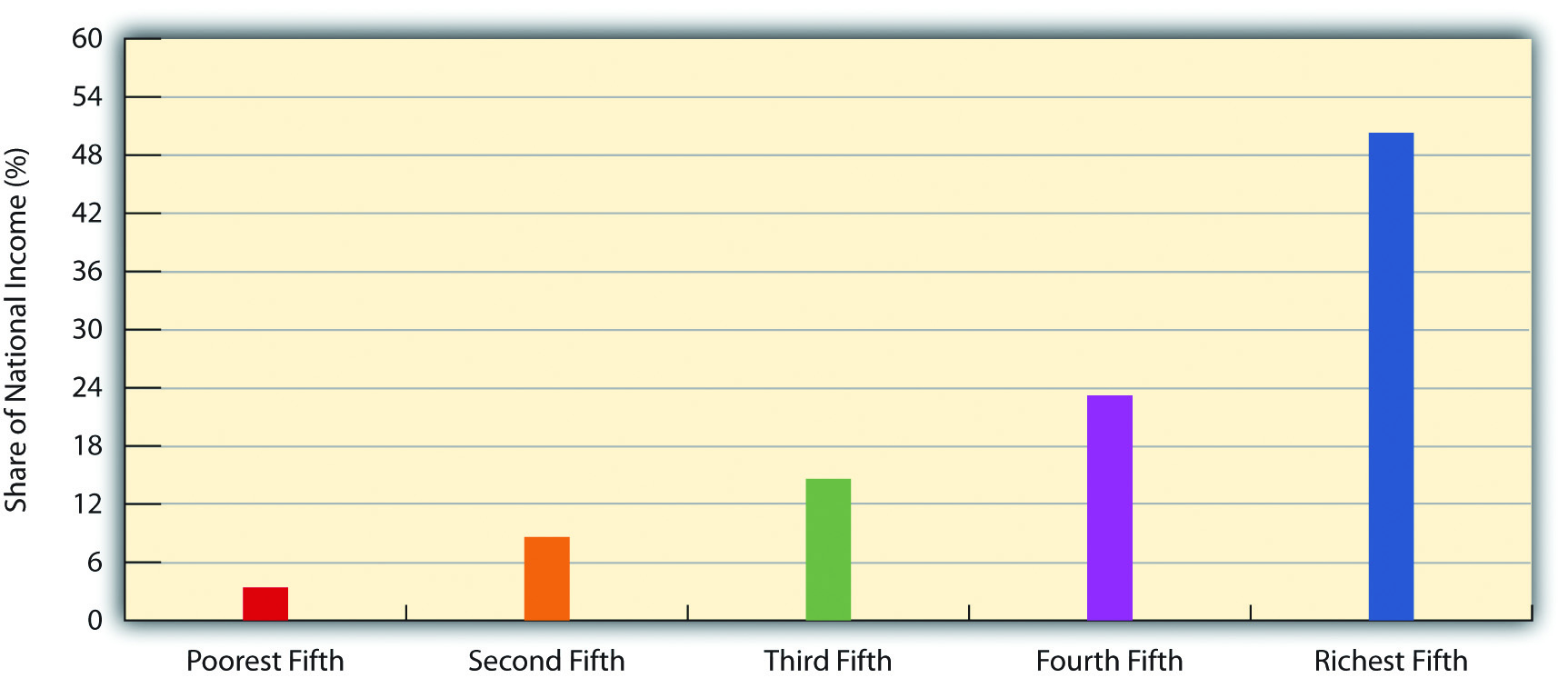
This degree of inequality is the largest in the industrialized world. "Income Inequality Around the World" compares the inequality among several industrialized nations by dividing the median income of households in the 90th percentile (meaning they have more income than 90% of all households) by the median income of households in the 10th percentile (meaning they have more income than only 10% of all households); the higher the resulting ratio, the greater a nation’s inequality. The ratio for the United States, 4.86, far exceeds that for any other nation.
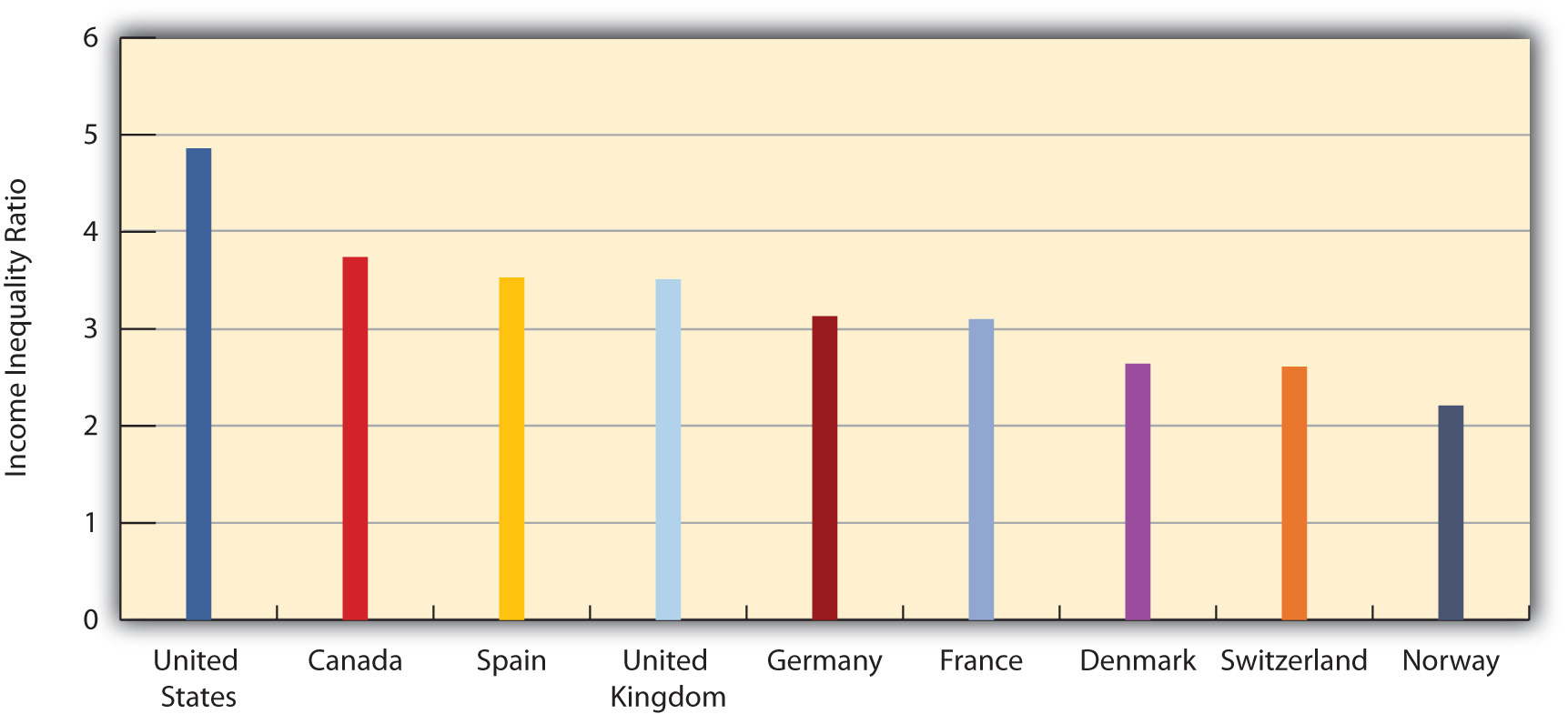
Poverty
Measuring Poverty
When U.S. officials became concerned about poverty during the 1960s, they quickly realized they needed to find out how much poverty we had. To do so, a measure of official poverty, or a poverty line, was needed. This line was first calculated in 1963 by multiplying the cost of a very minimal diet by three, as a 1955 government study had determined that the typical American family spent one-third of its income on food. Thus a family whose income is lower than three times the cost of a very minimal diet is considered officially poor.
This way of calculating the poverty line has not changed since 1963, even though many other things, such as energy, child care, and health care, now occupy a greater percentage of the typical family’s budget than was true in 1963. As a national measure, the poverty line also fails to take into account regional differences in the cost of living. For all of these reasons, many experts think the official measurement of poverty is highly suspect. As a recent report observed, “Most poverty analysts strongly believe that the official poverty statistics are inadequate to the task of determining who is poor in America” (Mishel, Bernstein, & Shierholz, 2009, p. 298). Mishel, L., Bernstein, J., & Shierholz, H. (2009). The state of working America 2008/2009. Ithaca, NY: ILR Press [An imprint of Cornell University Press].
The U.S. Census Bureau defines poverty in terms of the minimum annual income to by a family to survive. The minimum income is called the poverty level. The poverty level is adjusted annually for inflation and takes into account the number of people in a family: the larger the family size, the higher the poverty line. In 2009, the poverty line for a nonfarming family of four (two adults, two children) was $21,756. A four-person family earning even one more dollar than $21,756 in 2009 was not officially poor, even though its “extra” income hardly lifted it out of dire economic straits. Policy experts have calculated a no-frills budget that enables a family to meet its basic needs in food, clothing, shelter, and so forth; this budget is about twice the poverty line.
Families with incomes between the poverty line and twice the poverty line are barely making ends meet, but they are not considered officially poor. When we talk here about the poverty level, keep in mind that we are talking only about official poverty and that there are many families and individuals living in near-poverty who have trouble meeting their basic needs, especially when they face unusually high medical or motor vehicle expenses or the like. For this reason, some analyses use “twice-poverty” data (i.e., family incomes below twice the poverty line) to provide a more accurate understanding of how many Americans face serious financial difficulties.
| Family Size | Poverty Level |
|---|---|
| 1 Person | |
| Under 65 years | $10,787 |
| 65 years and over | $9,944 |
| 2 Persons | |
| Households under 65 years | $13,884 |
| Households 65 years and older | $12,533 |
| 3 Persons | $16,218 |
| 4 Persons | $21,386 |
| 5 Persons | $25,791 |
| 6 Persons | $29,664 |
| 7 Persons | $34,132 |
| 8 Persons | $38,174 |
| 9 Persons | $45,921 |
The Extent and Social Distribution of Poverty
How many Americans are poor, and who are they? The U.S. Census Bureau gives us some answers. In 2009, 14.3% of the U.S. population, or almost 44 million Americans, lived in (official) poverty (DeNavas-Walt, Proctor, & Smith, 2010).DeNavas-Walt, C., Proctor, B. D., & Smith, J. C. (2010). Income, poverty, and health insurance coverage in the United States: 2009 (Current Population Report P60-238). Washington, DC: U.S. Census Bureau. This percentage represented a decline from the early 1990s but was higher than the rate in the late 1960s. If we were winning the war on poverty in the 1960s, since then poverty has fought us to a standstill.
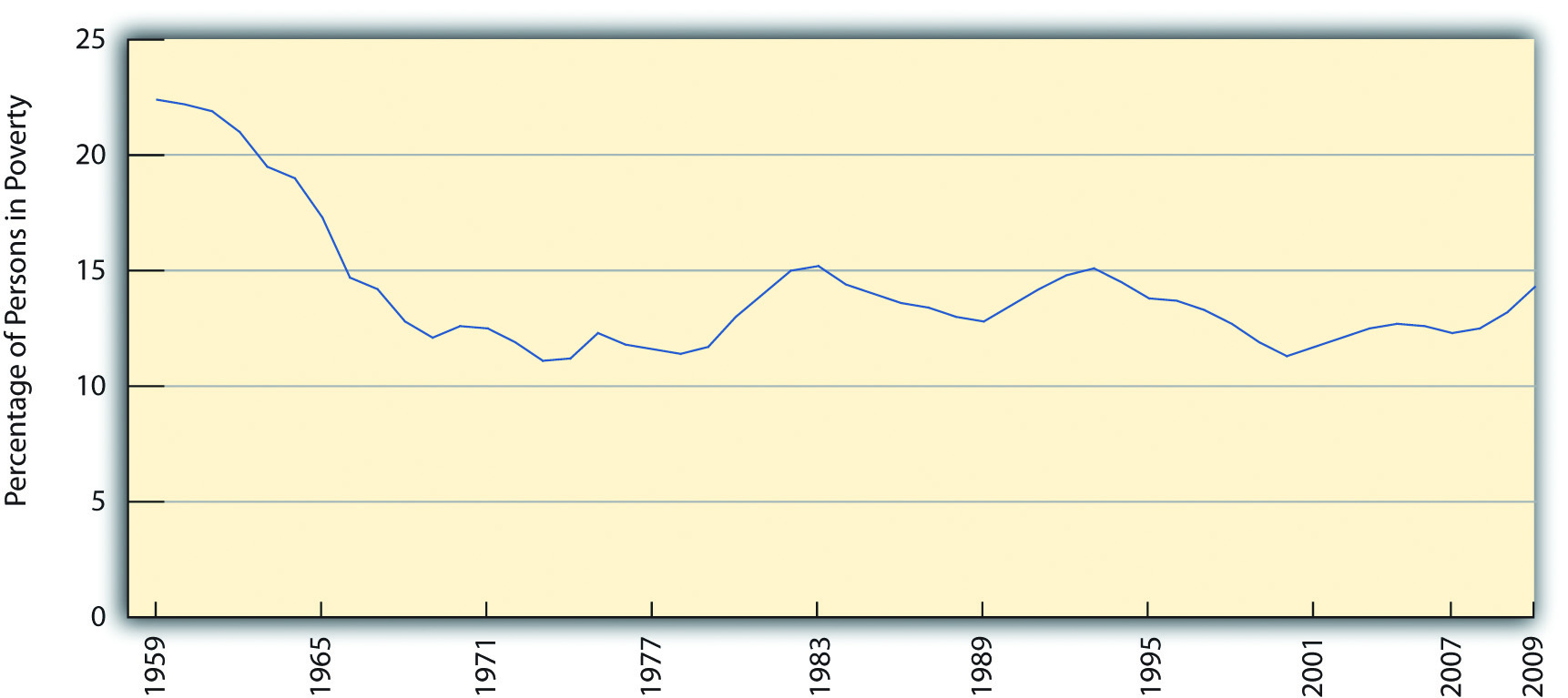
Another way of understanding the extent of poverty is to consider episodic poverty, defined by the Census Bureau as being poor for at least 2 consecutive months in some time period. From 2004 to 2007, the last years for which data are available, almost one-third of the U.S. public, equal to about 95 million people, were poor for at least 2 consecutive months, although only 2.2% were poor for all 3 years (DeNavas-Walt, Proctor, & Smith, 2010).DeNavas-Walt, C., Proctor, B. D., & Smith, J. C. (2010). Income, poverty, and health insurance coverage in the United States: 2009 (Current Population Report P60-238). Washington, DC: U.S. Census Bureau. As these figures indicate, people go into and out of poverty, but even those who go out of it do not usually move very far from it.

Who are the poor? Contrary to popular images, the most typical poor person in the United States is white: approximately 44% of poor people are white (non-Latino), 29% are Latino, 23% are black, and 4% are Asian (see Figure "Racial and Ethnic Composition of the Poor, 2009 (Percentage of Poor Persons in Each Group)"). At the same time, race and ethnicity affect the chances of being poor: while only 9.4% of non-Latino whites are poor, 25.8% of African Americans, 12.5% of Asians, and 25.3% of Latinos (who may be of any race) are poor (see Figure "Race, Ethnicity, and Poverty, 2009 (Percentage of Each Group That Is Poor)"). Thus African Americans and Latinos are almost three times as likely as non-Latino whites to be poor.
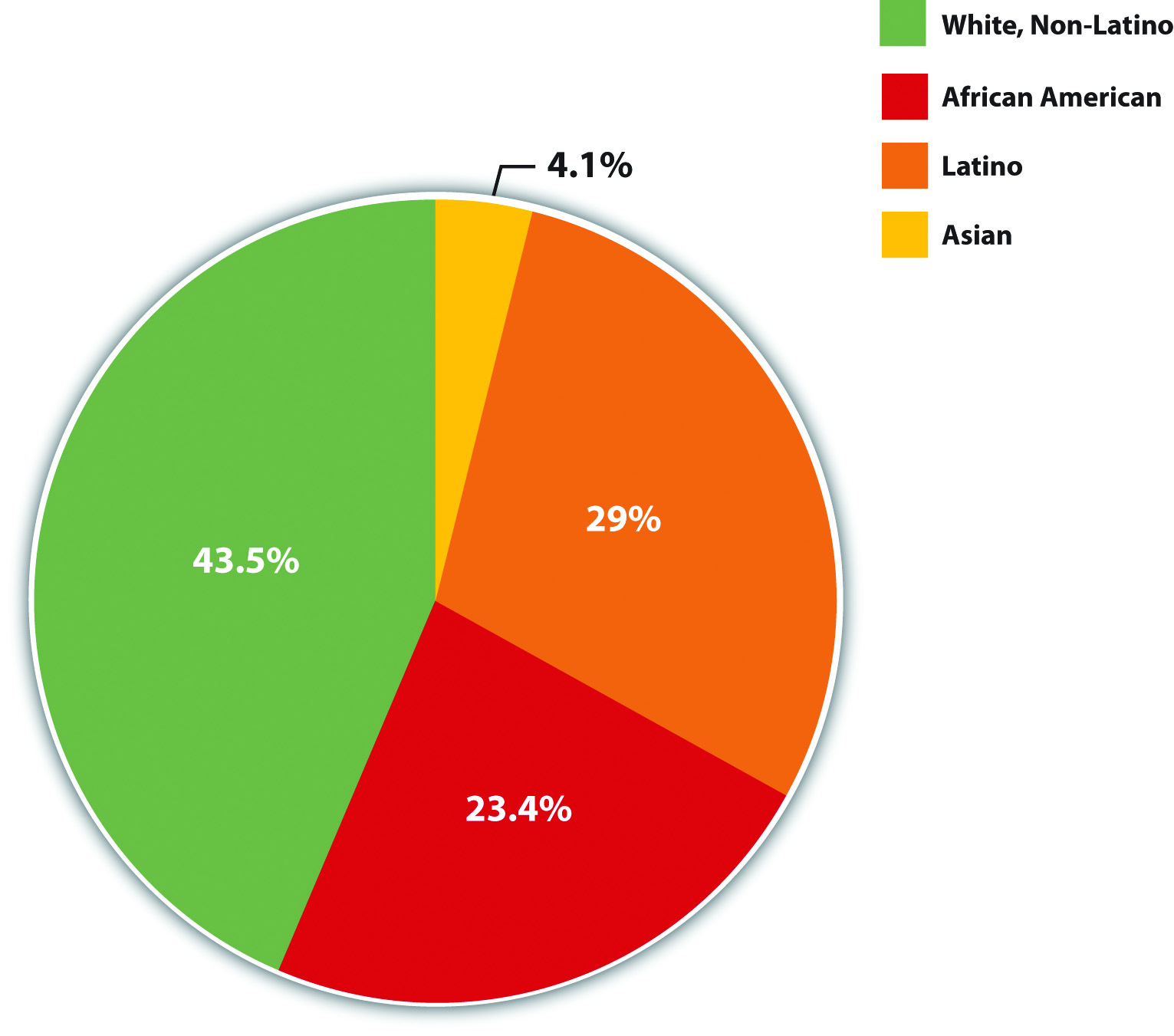
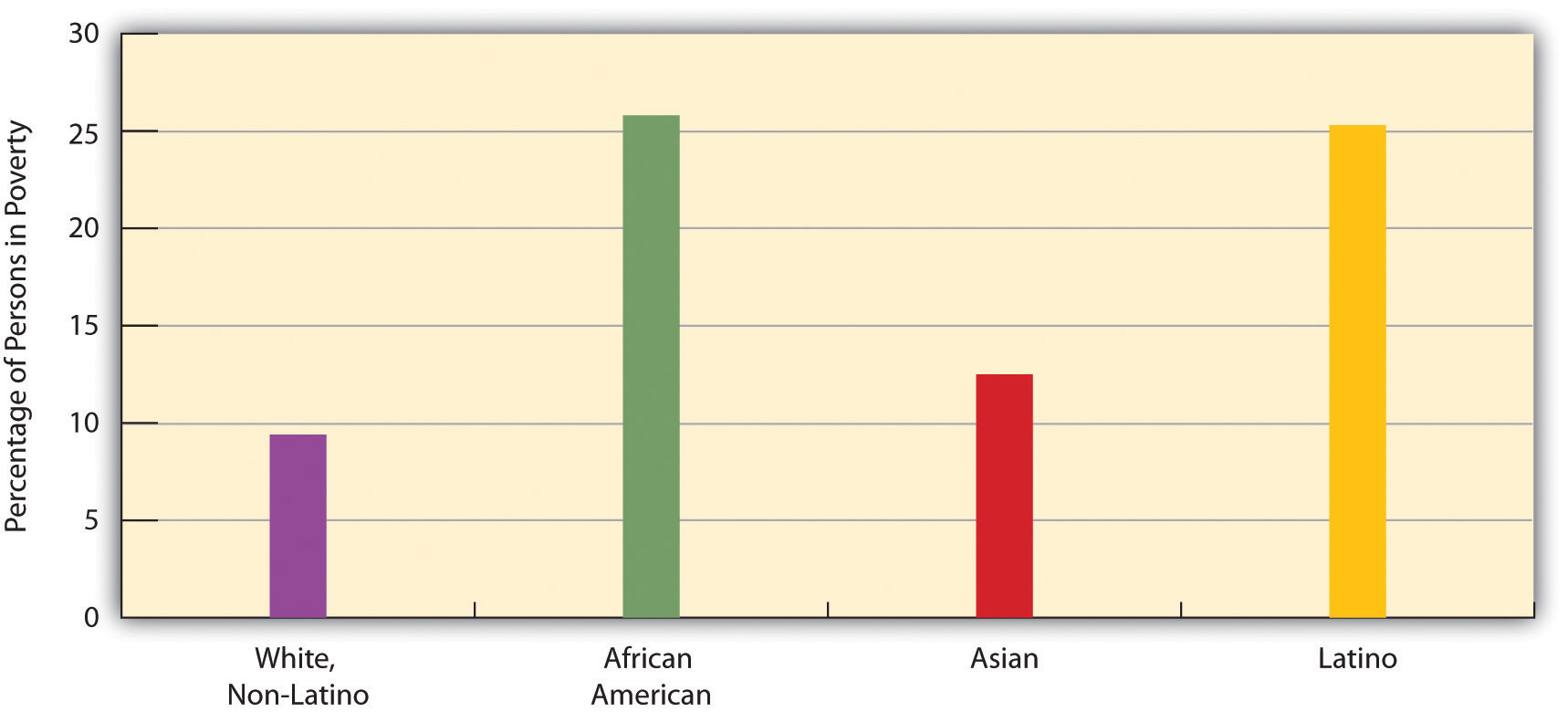
Turning to age, almost 21% of children under age 18 are poor (amounting to more than 15 million children), including 35.7% of African American children and 33.1% of Latino children (DeNavas-Walt, Proctor, & Smith, 2010).DeNavas-Walt, C., Proctor, B. D., & Smith, J. C. (2010). Income, poverty, and health insurance coverage in the United States: 2009 (Current Population Report P60-238). Washington, DC: U.S. Census Bureau.
The poverty rate for U.S. children is the highest in the Western world and 1.5 to 9 times greater than the corresponding rates in Canada and Western Europe (Mishel, Bernstein, & Shierholz, 2009).Mishel, L., Bernstein, J., & Shierholz, H. (2009). At the other end of the age distribution, 8.9% of people aged 65 or older are poor (amounting to about 3.4 million seniors). Turning around these U.S. figures, about 36% of all poor people in the United States are children, and about 8% of the poor are 65 or older. Thus some 44% of Americans living in poverty are children or the elderly.
The type of family structure also makes a difference: whereas only 8.5% of children living with married parents live in poverty, 43% of those living with only their mother live in poverty (2007 data). This latter figure is about 32% for Asian children and for non-Latino white children and rises to slightly more than 50% for African American children and Latino children (Moore, Redd, Burkhauser, Mbawa, & Collins, 2009).Moore, K. A., Redd, Z., Burkhauser, M., Mbawa, K., & Collins, A. (2009). As these latter numbers indicate, families headed by a single woman are much more likely to be poor. Poverty thus has a female face.
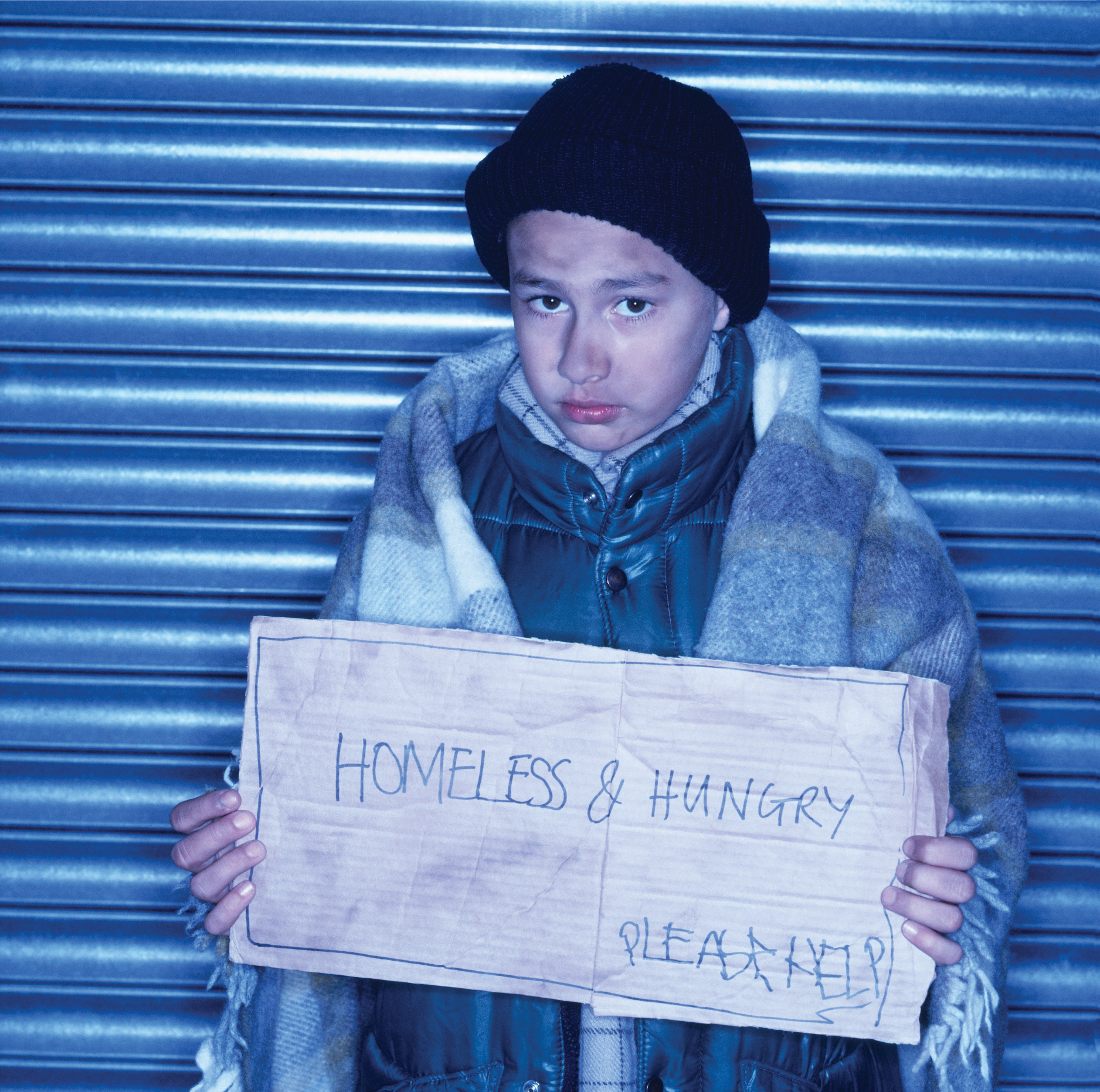
Explaining Poverty
Explanations of poverty focus on problems either within the poor themselves or in the society in which they live (Iceland, 2006). Iceland, J. (2006). Poverty in America: A handbook. Berkeley: University of California Press. The first type of explanation follows logically from the functional theory of stratification and may be considered an “individual” explanation. The second type of explanation follows from conflict theory and is a structural explanation that focuses on problems in American society that produce poverty.
According to the individual explanation, the poor have personal problems and deficiencies that are responsible for their poverty. In the past, the poor were thought to be biologically inferior, a view that has not entirely faded, but today the much more common belief is that they lack the ambition and motivation to work hard and to achieve. According to the World Values Survey, 60% of Americans believe that people are poor “because they are lazy and lack will power.” This percentage reflects the tendency of Americans to favor individual explanations of poverty (Davidson, 2009). Davidson, T. C. (2009). Attributions for poverty among college students: The impact of service-learning and religiosity. College Student Journal, 43, 136–144.
A more sophisticated version of this type of explanation is called the culture of poverty theory (Banfield, 1974; O. Lewis, 1966). Banfield, E. C. (1974). The unheavenly city revisited. Boston, MA: Little, Brown; Lewis, O. (1966). The culture of poverty. Scientific American, 113, 19–25. According to this theory, the poor generally have beliefs and values that differ from those of the nonpoor and that doom them to continued poverty. For example, they are said to be impulsive and to live for the present rather than the future. Critics say this view exaggerates the degree to which the poor and nonpoor do in fact hold different values and ignores discrimination and other problems in American society (Iceland, 2006). Iceland, J. (2006). Poverty in America: A handbook. Berkeley: University of California Press.
According to the second, structural explanation, U.S. poverty stems from problems in American society that lead to a lack of equal opportunity. These problems include (a) racial, ethnic, gender, and age discrimination; (b) lack of good schooling and adequate health care; and (c) structural changes in the American economic system, such as the departure of manufacturing companies from American cities in the 1980s and 1990s (Iceland, 2003). Iceland, J. (2003). Dynamics of economic well-being, 1996–1999 (Current Population Report P70–91). Washington, DC: U.S. Census Bureau. These problems help create a vicious cycle of poverty in which children of the poor are often fated to end up in poverty or near-poverty themselves as adults.
The Effects of Poverty
However poverty is explained, it has important and enduring effects. For now, we can list some of the major consequences of poverty (and near-poverty) in the United States. As we do so, recall the sociological perspective’s emphasis on how our social backgrounds influence our attitudes, behaviors, and life chances. This influence on life chances is quite evident when we look at some of the effects of poverty (Moore, Redd, Burkhauser, Mbawa, & Collins, 2009; Iceland, 2006; D. Lindsey, 2009): Moore, K. A., Redd, Z., Burkhauser, M., Mbawa, K., & Collins, A. (2009). Children in poverty: Trends, consequences, and policy options. Washington, DC: Child Trends. Retrieved from http://www.childtrends.org/Files//Child_Trends-2009_04_07_RB_ChildreninPoverty.pdf; Iceland, J. (2006). Poverty in America: A handbook. Berkeley: University of California Press; Lindsey, D. (2009). Child poverty and inequality: Securing a better future for America’s children. New York, NY: Oxford University Press.
- The poor are at greater risk for family problems, including divorce and domestic violence. The stress of being poor is thought to be a major reason for these problems.
- The poor are also at greater risk for health problems, including infant mortality, earlier mortality during adulthood, mental illness, and inadequate medical care. Many poor people lack health insurance. Poor children are more likely to have inadequate nutrition and to suffer health, behavioral, and cognitive problems. These problems in turn impair their ability to do well in school and land stable employment as adults, helping to ensure that poverty will persist across generations.
- Poor children typically go to rundown schools with inadequate facilities where they receive inadequate schooling. They are much less likely than nonpoor children to graduate from high school or to go to college. Their lack of education in turn restricts them and their own children to poverty, once again helping to ensure a vicious cycle of continuing poverty across generations.
- The poor are, not surprisingly, more likely to be homeless than the nonpoor but also more likely to live in dilapidated housing and unable to buy their own homes. Many poor families spend more than half their income on rent. The lack of adequate housing for the poor remains a major national problem.

